Gastro Urinary Systems Medication
Total Questions : 44
Showing 25 questions, Sign in for moreA nurse is reinforcing teaching about cimetidine with a client who has peptic ulcer disease. Which of the following information should the nurse include in the teaching?
Explanation
Cimetidine is a medication known as a histamine H2 receptor antagonist, commonly used in the treatment of peptic ulcer disease. It works by reducing the production of stomach acid. When teaching a client about cimetidine, it is important to inform them about the timing of taking other medications, specifically antacids.
Antacids, which are used to neutralize stomach acid, can interfere with the absorption of cimetidine if taken simultaneously. Therefore, it is generally recommended to wait at least 1 hour after taking cimetidine before taking an antacid. This allows sufficient time for the cimetidine to be absorbed and start working effectively before neutralizing stomach acid with an antacid.
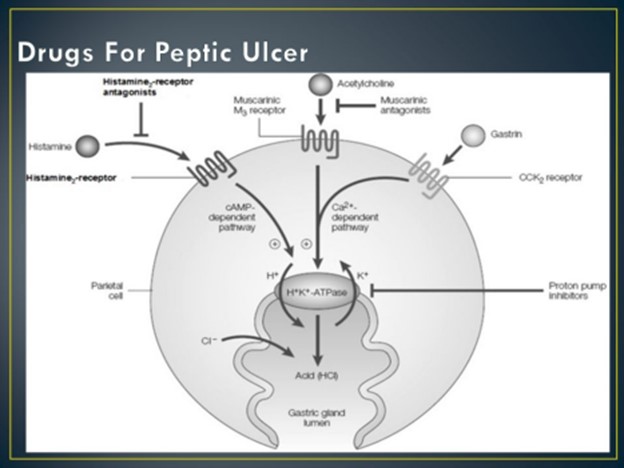
A nurse is reinforcing teaching a client who has peptic ulcer disease and is starting therapy with sucralfate. Which of the following instructions should the nurse include in the teaching?
Explanation
Sucralfate is a medication commonly used in the treatment of peptic ulcer disease. It works by forming a protective barrier over the ulcer site, providing a physical barrier against gastric acid, and promoting the healing process. When teaching a client about sucralfate, it is important to provide instructions regarding its proper administration.
One of the key instructions is to take sucralfate 1 hour before meals. This timing allows the medication to form a protective coating in the stomach before food is ingested. Taking sucralfate on an empty stomach enhances its effectiveness in protecting the ulcer and promoting healing.
"Take the medication with an antacid" - Sucralfate should not be taken with an antacid. Antacids can interfere with the protective mechanism of sucralfate by neutralizing stomach acid, which is necessary for sucralfate to bind and form a protective coating. It is recommended to wait at least 30 minutes to 1 hour after taking sucralfate before taking an antacid.
"Take as needed for pain relief" - Sucralfate is not typically used for immediate pain relief in peptic ulcer disease. It is primarily used for its protective and healing properties. Pain relief is
usually addressed with other medications, such as antacids, acid-reducing medications, or pain medications as prescribed by a healthcare provider.
"Store the medication in the refrigerator" - Sucralfate does not require refrigeration. It should be stored at room temperature, away from excessive heat or moisture, as per the specific instructions provided by the manufacturer or healthcare provider.
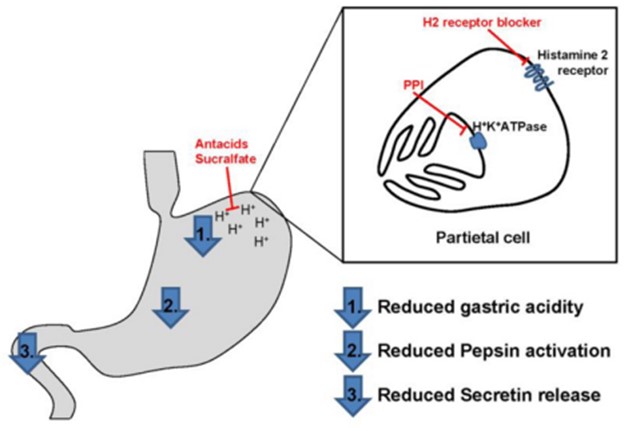
A nurse is collecting data from a client who has peptic ulcer disease. Which of the following findings is a manifestation of gastrointestinal perforation?
Explanation
The manifestation of gastrointestinal perforation includes severe upper abdominal pain. This can be a significant symptom indicating a potential perforation in the gastrointestinal tract. It is important to note that gastrointestinal perforation is a medical emergency that requires immediate attention and intervention.
Hyperactive bowel sounds: This finding is more commonly associated with conditions like bowel obstruction or gastroenteritis rather than gastrointestinal perforation.
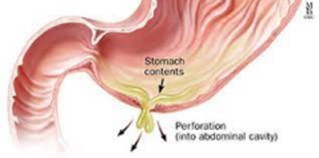
Bradycardia: Bradycardia (slower than normal heart rate) is not a typical manifestation of gastrointestinal perforation. It may be associated with other conditions or factors.
Report of epigastric fullness: Epigastric fullness can be a symptom of various gastrointestinal conditions, including peptic ulcer disease itself. However, it is not a specific manifestation of gastrointestinal perforation.
A nurse is caring for a client who has cirrhosis and a prescription for lactulose. Following administration, the nurse should monitor the client for which of the following adverse effects?
Explanation
After administering lactulose to a client with cirrhosis, the nurse should monitor for the adverse effects of diarrhea. Lactulose is a laxative commonly used in the treatment of hepatic encephalopathy, which can occur in individuals with cirrhosis. One of the intended effects of lactulose is to promote bowel movements and reduce the absorption of ammonia in the gut, thus helping to manage hepatic encephalopathy.
While lactulose can cause adverse effects such as diarrhea, it is not typically associated with peripheral edema. Peripheral edema is often seen in cirrhosis due to fluid retention caused by liver dysfunction.
Dry mouth and headache are less commonly associated with lactulose use and are not typically the primary adverse effects to monitor for in this scenario.

A nurse is planning care for a client who has a peptic ulcer and a new prescription for sucralfate 2 gm administered twice daily. Which of the following times should the nurse plan to administer the medication?
Explanation
Sucralfate is a medication used to treat peptic ulcers by forming a protective coating on the stomach lining. It should be taken on an empty stomach, as food can interfere with its absorption and effectiveness. One hour before breakfast and the evening meal is the correct timing for administering sucralfate, allowing for an empty stomach before meals.
At the time the client takes a proton pump inhibitor: Proton pump inhibitors are a different class of medications used to reduce stomach acid production. It is recommended to administer sucralfate separately, as it works differently and has different administration requirements.
Thirty minutes after breakfast and the evening meal: Administering sucralfate after meals is not ideal, as it may not provide the desired therapeutic effect on an empty stomach.
The time the client takes an antacid: Antacids are also different from sucralfate, and they can interfere with its absorption. It is generally recommended to administer sucralfate separately from antacids.
A nurse is caring for a client who receives intermittent enteral feedings through an NG tube. Before administering a feeding, the nurse should measure the gastric residual for which of the following purposes?
Explanation
The nurse should measure the gastric residual before administering a feeding to identify delayed gastric emptying. Gastric residual refers to the volume of formula or contents remaining in the stomach from the previous feeding. Measuring gastric residual helps assess how well the client's stomach is emptying and can indicate if there is delayed gastric emptying.
By measuring gastric residual, the nurse can:
● Determine if the stomach has adequately emptied from the previous feeding. ● Assess the client's tolerance to enteral feedings.
● Detect signs of delayed gastric emptying, which can be indicative of gastrointestinal motility issues or other complications.
● Adjust the feeding rate or make other modifications to the enteral feeding plan based on the amount of residual volume.
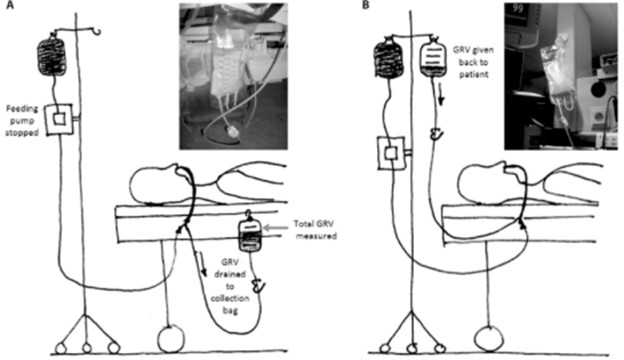
Confirming the placement of the NG tube is typically done using other methods, such as an X-ray, pH testing, or auscultation of air insufflation. Gastric residual measurement primarily serves the purpose of assessing gastric emptying, rather than confirming tube placement.
While electrolyte imbalances can be monitored in the overall care of a client receiving enteral feedings, measuring gastric residual specifically focuses on assessing gastric emptying and feeding tolerance, rather than determining the client's electrolyte balance.
Removing gastric acid that might cause dyspepsia is not the primary purpose of measuring gastric residual. Gastric residual measurement aims to evaluate the volume of the previous feeding and assess gastric emptying, rather than focusing on dyspepsia specifically.
A nurse is collecting data from a client in the health clinic who is reporting epigastric pain. Which of the following statements made by the client should the nurse identify as being consistent with peptic ulcer disease?
Explanation
Peptic ulcer disease is characterized by open sores that develop on the lining of the stomach, small intestine, or esophagus. The symptoms and pain associated with peptic ulcer disease can
vary, but certain patterns are commonly observed: "The pain is worse after I eat a meal high in fat": This statement aligns with the typical symptom of peptic ulcer disease. The presence of fat in the stomach triggers the release of certain hormones and substances that stimulate gastric acid secretion. This increased acid production can exacerbate the pain experienced by individuals with peptic ulcers.
"I feel so much better after eating": Feeling relief after eating is not characteristic of peptic ulcer disease. In fact, individuals with peptic ulcers may experience pain or discomfort after eating.
"The pain radiates down to my lower back": Lower back pain is not a common symptom associated specifically with peptic ulcer disease. Radiating pain to the back is more commonly associated with conditions like pancreatitis or kidney issues.
"My pain is relieved by having a bowel movement": Pain relief with bowel movements is not a typical symptom of peptic ulcer disease. It may be more indicative of conditions like irritable bowel syndrome or inflammatory bowel disease.
A nurse is reinforcing teaching with a client who reports taking bisacodyl daily. Which of the following information should the nurse include?
Explanation
Bisacodyl is a stimulant laxative commonly used to treat constipation. However, it is important to educate the client about the potential risks associated with chronic laxative use. The statement regarding electrolyte imbalance is important because excessive or prolonged use of laxatives can lead to electrolyte disturbances, such as low potassium levels (hypokalemia), which can have adverse effects on various body functions.
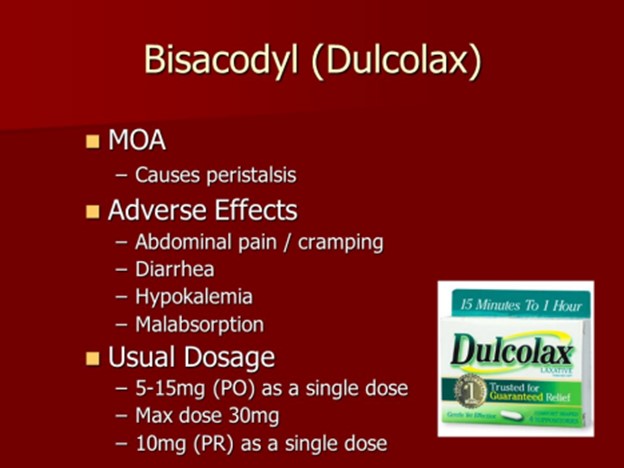
"Daily bowel movements are necessary for good intestinal health": While regular bowel movements are generally desirable, stating that daily bowel movements are necessary for good intestinal health is an overgeneralization. Bowel movement frequency can vary among individuals, and it is important to consider other factors such as diet, hydration, and overall health.
"Chronic use of laxatives can lead to a tear in the rectal mucosa": While chronic use of laxatives can lead to complications such as dependence and potential damage to the digestive system, specifically mentioning a tear in the rectal mucosa (rectal mucosal injury) is not the most commonly associated concern.
"Decrease your intake of high-fiber foods": It is generally recommended to increase fiber intake for individuals with constipation. Decreasing high-fiber foods would counteract the benefits of dietary fiber in promoting regular bowel movements and alleviating constipation.
A nurse is reinforcing teaching for a client who has a duodenal ulcer and a new prescription for sucralfate. The client asks the nurse how sucralfate works. Which of the following statements should the nurse make?
Explanation
Sucralfate works by forming a protective barrier or coating over the surface of the ulcer. It adheres to the ulcer site and provides a physical barrier that protects the ulcer from gastric acid, pepsin, and bile salts. This protective barrier allows the ulcer to heal by preventing further damage and irritation from the stomach acid.
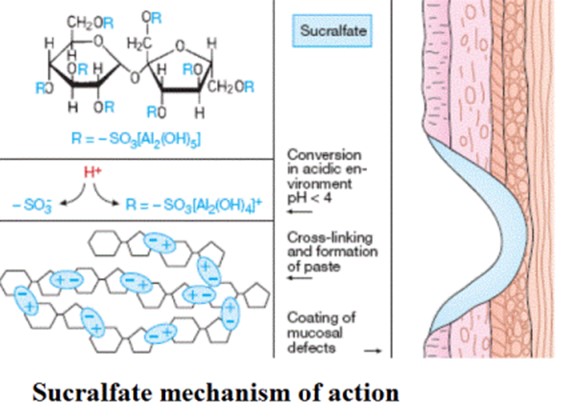
A nurse is caring for a client who has gastroesophageal disease and a prescription for metoclopramide. For which of the following adverse effects should the monitor?
Explanation
Metoclopramide is a medication commonly used to treat gastrointestinal disorders such as gastroesophageal reflux disease (GERD). While it is generally well-tolerated, it can have some adverse effects. Sedation is one of the common side effects of metoclopramide. It can cause drowsiness, dizziness, and a feeling of tiredness in some individuals. Therefore, the nurse should monitor the client for any signs of sedation or excessive drowsiness, especially when the client starts taking the medication or when the dose is increased.

Hypertension: Metoclopramide is not known to cause hypertension (high blood pressure) as a common side effect. In fact, it may have a mild hypotensive (blood pressure-lowering) effect in some individuals.
Urinary retention: Metoclopramide does not typically cause urinary retention. Instead, it can enhance gastrointestinal motility and increase the frequency of bowel movements.
Blurred vision: While visual disturbances are rare adverse effects of metoclopramide, blurred vision is not a commonly reported side effect. However, other visual disturbances like oculogyric crisis (involuntary rolling back of the eyes) have been reported in rare cases. Nevertheless, monitoring for blurred vision specifically is not a priority when administering metoclopramide.
A nurse is collecting data from a client who has been taking omeprazole for the past 4 weeks. The nurse determines that the medication is effective when the client reports relief from which of the following symptoms?
Explanation
Omeprazole is a proton pump inhibitor (PPI) commonly prescribed to reduce stomach acid production. It is frequently used to treat conditions such as gastroesophageal reflux disease (GERD) and peptic ulcer disease. Acid indigestion, characterized by a burning sensation in the chest or upper abdomen, is a common symptom of excessive stomach acid.
While omeprazole can indirectly alleviate certain symptoms associated with excessive stomach acid, it is not typically used to directly treat or relieve symptoms such as nausea, diarrhea, or headaches. Other medications or interventions may be more suitable for managing these specific symptoms.
A nurse is caring for a client who is taking furosemide. For which of the following adverse effects should the nurse monitor?
Explanation
Furosemide is a loop diuretic that helps the body get rid of excess fluid by increasing urine output. However, it also promotes the loss of potassium in the urine, leading to a potential decrease in the body's potassium levels.
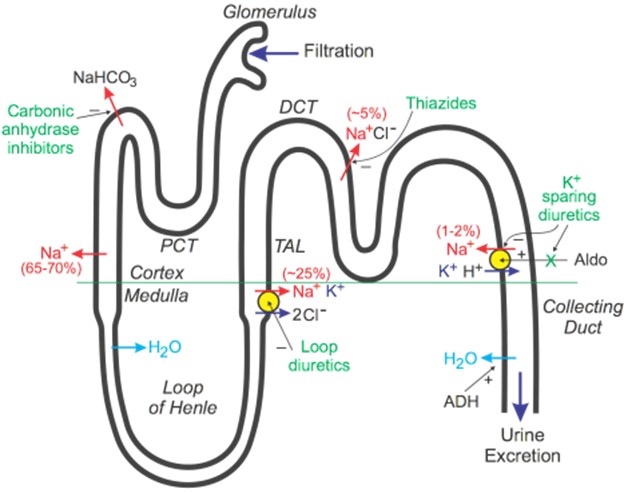
A nurse caring for a client who has a new prescription for atenolol. For which of the following adverse effects should the nurse monitor the clients
Explanation
Atenolol is a beta-blocker medication commonly used to treat conditions such as hypertension (high blood pressure) and certain heart rhythm disorders. One of the intended effects of atenolol is to lower the heart rate by blocking the action of adrenaline on beta receptors in the heart. However, this can sometimes result in bradycardia, which refers to a heart rate that is slower than the normal range.

Hypokalemia, or low potassium levels, is not directly caused by atenolol but can be an indirect effect. Beta-blockers like atenolol can potentially interfere with the normal release of insulin and contribute to increased urinary excretion of potassium. Therefore, it's important to monitor potassium levels in clients taking atenolol, as low potassium levels can have adverse effects on various body systems.
Anemia and neutropenia are not typically associated with the use of atenolol. Anemia refers to a decrease in the number of red blood cells or a decrease in the amount of hemoglobin, which carries oxygen to the body tissues. Neutropenia refers to a decrease in the number of neutrophils, which are a type of white blood cell involved in fighting infection.
A nurse is reinforcing teaching with a client who has a new prescription for aluminum hydroxide to treat heartburn. Which of the following adverse effects of the medication should the nurse include in the teaching?
Explanation
When reinforcing teaching with a client who has a new prescription for aluminum hydroxide to treat heartburn, the nurse should include constipation as an adverse effect of the medication. Aluminum hydroxide is an antacid commonly used to neutralize stomach acid and provide relief from heartburn and indigestion. However, one of its potential side effects is constipation. Aluminum hydroxide can slow down intestinal motility, leading to infrequent or difficult bowel movements.
Hypertension: Aluminum hydroxide is not known to cause hypertension (high blood pressure). However, clients with pre-existing hypertension should be cautious when using antacids containing sodium bicarbonate, as the sodium content may impact blood pressure levels.
Flatulence: Flatulence (excessive gas) is not a common adverse effect of aluminum hydroxide. It primarily works by neutralizing stomach acid and does not typically cause increased gas production.
Headache: Headache is not commonly reported as an adverse effect of aluminum hydroxide. It is more likely to be associated with other factors such as the underlying condition causing heartburn or individual factors.
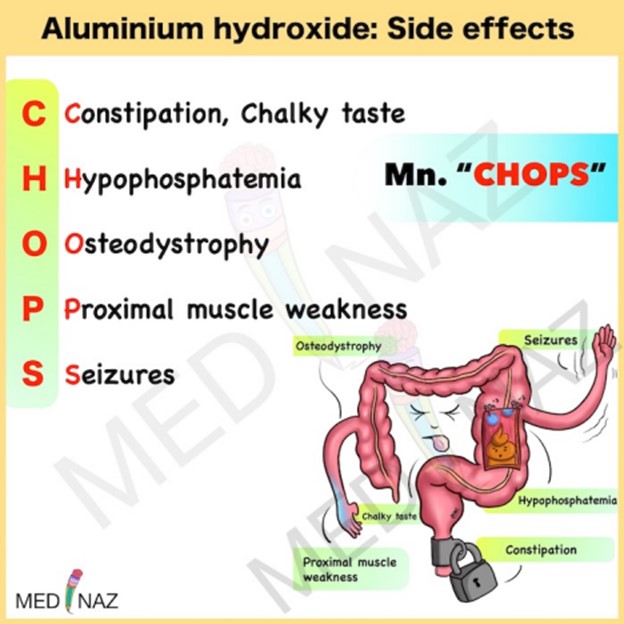
A nurse is preparing to administer a bolus enteral feeding to a client who has a gastrostomy tube. Which of the following actions should the nurse take first?
Explanation
Elevating the head of the bed to a semi-Fowler's or high Fowler's position helps prevent aspiration during the feeding. This position facilitates proper digestion and reduces the risk of
regurgitation or reflux. It allows gravity to assist in keeping the feeding in the stomach and reduces the likelihood of complications.
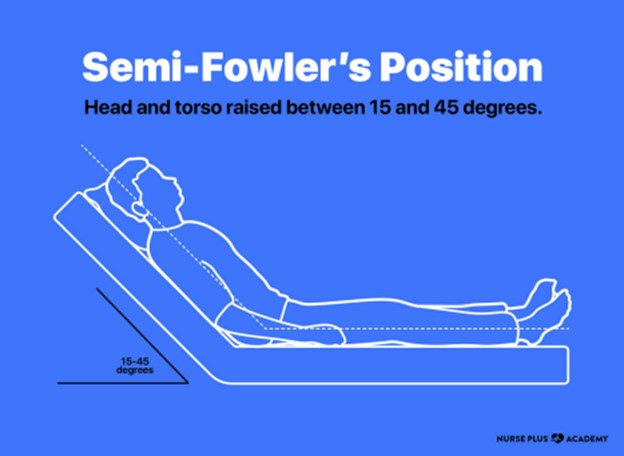
The other actions mentioned are also important steps in the process but should be performed after elevating the head of the bed:
Measure stomach contents: This step is usually done before administering any enteral feeding to check for the presence of residual gastric contents. It helps determine if the client is tolerating previous feedings and guides adjustments in the feeding volume or rate if needed.
Return gastric content into the gastrostomy tube: If there is a significant amount of gastric residual, it is recommended to return the contents into the stomach before administering the feeding. This helps ensure that the client receives the full prescribed amount of the enteral feeding.
Flush the tube with water: Flushing the gastrostomy tube with water before and after the feeding helps maintain tube patency, clears any residual feeding or medication, and prevents clogging.
A nurse is administering a tap-water enema to a client. The client reports cramping as the nurse instills the irrigating solution. Which of the following actions should the nurse take to relieve the client's discomfort?
Explanation
When the client experiences cramping during the enema administration, it indicates that the colon is becoming distended. By allowing the client to expel some of the fluid, the pressure in the colon is reduced, which can help alleviate the discomfort and cramping. The nurse should pause the administration of the enema and allow the client to release some fluid before continuing.
The other options mentioned are not appropriate or effective actions to relieve the client's discomfort:
Lowering the height of the solution container: Lowering the height of the solution container will decrease the force of the fluid flow but may not address the underlying cause of the cramping. Allowing the client to expel some fluid is a more appropriate intervention.
Stopping the enema and documenting that the client did not tolerate the procedure: While it is important to monitor the client's tolerance during the procedure, abruptly stopping the enema and documenting intolerance may not be necessary if the discomfort can be relieved by allowing the client to expel some fluid. The nurse should prioritize relieving the discomfort before deciding to stop the procedure.
Encouraging the client to bear down: Bearing down or pushing can increase intra-abdominal pressure and exacerbate the cramping. This action is not recommended in this situation.
A nurse is reinforcing teaching about cimetidine with a client who has peptic ulcer disease. Which of the following information should the nurse include in the teaching?
Explanation
When reinforcing teaching about cimetidine with a client who has peptic ulcer disease, the nurse should include the following information:
"Wait at least 1 hour after taking the medication before taking an antacid.": Cimetidine is a histamine-2 receptor antagonist that reduces stomach acid production. Taking an antacid too close in time to cimetidine may decrease its effectiveness as antacids can interfere with its absorption. The nurse should advise the client to follow the healthcare provider's instructions regarding the timing and administration of cimetidine and antacids.
The following statements are incorrect or not applicable:
"Expect breast tenderness while taking this medication.": Breast tenderness is not a common side effect of cimetidine. If the client experiences any unusual symptoms or side effects while taking the medication, they should consult their healthcare provider for further evaluation.
"Take this medication on an empty stomach.": To reduce stomach upset, this medication should be taken with food or milk
"Take ibuprofen for occasional aches and pains.": Ibuprofen is a nonsteroidal anti-inflammatory drug (NSAID) that can increase the risk of gastrointestinal complications, including ulcers. In individuals with peptic ulcer disease, it is generally recommended to avoid NSAIDs unless specifically prescribed by a healthcare provider. The nurse should emphasize the importance of discussing any pain management strategies or medications with the healthcare provider before use.
A nurse is reviewing the medical record of a client who has a peptic ulcer. Which of the following findings should the nurse identify as a risk factor for this condition?
Explanation
Ibuprofen is a nonsteroidal anti-inflammatory drug (NSAID) that can increase the risk of developing peptic ulcers. It can cause irritation and damage to the lining of the stomach and small intestine, leading to the formation of ulcers.
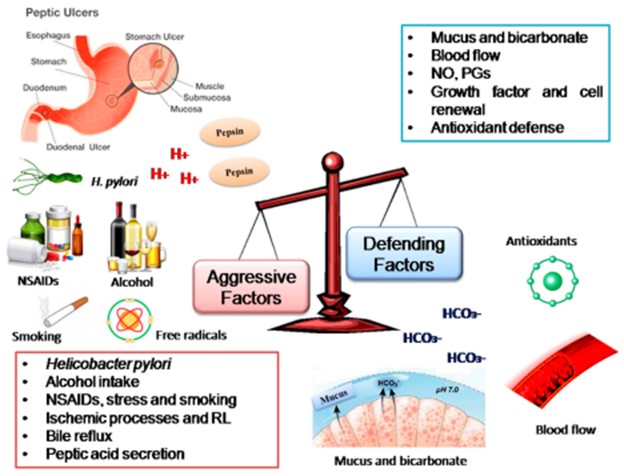
The other options may not directly contribute to the development of peptic ulcers:
History of bulimia: While repeated vomiting can irritate the esophagus, it is less likely to directly cause peptic ulcers.
Consuming spicy foods 5 to 8 times weekly: Spicy foods can exacerbate the symptoms of existing peptic ulcers, but they are not considered a direct risk factor for their development.
Drinking green tea: Green tea is generally considered to have health benefits and is not known to be a risk factor for peptic ulcers.
A nurse is obtaining a urine specimen for culture and sensitivity via a straight catheterization. Which of the following actions should the nurse take?
Explanation
When collecting a urine specimen via straight catheterization, it is important to use a sterile specimen container to maintain the integrity of the sample and prevent contamination. Using a non-sterile container can introduce bacteria and affect the accuracy of the culture and sensitivity results.
The other options mentioned are incorrect:
Using sterile water to inflate the balloon: This action is relevant when inflating the balloon of an indwelling urinary catheter, but in a straight catheterization, there is no balloon involved.
Instructing the client to clean from front to back with an antiseptic solution: This instruction is appropriate for cleaning the urethral meatus before inserting an indwelling urinary catheter, but in a straight catheterization, the nurse performs the procedure using sterile technique and does not require the client to clean themselves.
Collecting urine from the catheter's port: In a straight catheterization, the nurse collects urine directly from the catheter tube using a sterile syringe or collection container, rather than from a separate port.
A nurse is collecting data from a client who has gastroesophageal reflux disease (GERD) and reports having heartburn every night. Which of the following actions should the nurse identify as a contributing factor to the client's heartburn?
Explanation
Gastroesophageal reflux disease (GERD) is a condition characterized by the backflow of stomach acid into the esophagus, causing symptoms such as heartburn. Orange juice is highly acidic, and consuming acidic foods and beverages can exacerbate the symptoms of GERD. The acidic nature of orange juice can irritate the esophagus and contribute to increased acid reflux, leading to heartburn.
Sleeping on a large wedge-style pillow can actually help alleviate symptoms of GERD by elevating the head and upper body, reducing the likelihood of acid reflux during sleep.
Eating dinner early in the evening is generally recommended for individuals with GERD as it allows sufficient time for digestion before lying down. This can help prevent acid reflux during sleep.
Consuming low-fat meats is also a favorable choice for individuals with GERD as fatty foods can relax the lower esophageal sphincter, allowing stomach acid to flow back into the esophagus. However, the options provided do not include any fatty foods, so it is not the primary contributing factor to the client's heartburn in this case.
A nurse is reinforcing teaching with a client who has a new prescription for docusate sodium. The nurse should recognize which of the following statements indicates the client understands the teaching?
Explanation
Docusate sodium is a stool softener used to relieve constipation by promoting easier passage of stool. It works by increasing the amount of water absorbed by the stool, making it softer. Drinking an adequate amount of water is important when taking docusate sodium to help facilitate the softening and movement of stool.
The other statements indicate a lack of understanding:
"I can take this medication with mineral oil": Docusate sodium should not be taken with mineral oil because mineral oil can decrease its effectiveness. They should be taken separately.
"I will take the medication for diarrhea": Docusate sodium is not typically used for diarrhea as it is primarily used to treat constipation.
"I will have soft stools 1 to 3 days after starting this medication": The onset of action for docusate sodium is usually within 1 to 3 days, but this statement does not necessarily demonstrate an understanding of the teaching.
A nurse is caring for an older adult client who has cancer and is receiving opioids for pain relief. The client has a new prescription for docusate PO daily. When collecting data from the client, which of the following therapeutic effects of docusate should the nurse expect?
Explanation
Docusate is a stool softener commonly used to relieve constipation. Opioid pain medications often cause constipation as a side effect by slowing down bowel movements. Docusate helps by increasing the amount of water absorbed by the stool, making it softer and easier to pass.
The other options mentioned are not the primary therapeutic effects of docusate: Relief from nausea: Docusate is not typically prescribed for relief from nausea. Antiemetic medications are used to alleviate nausea and vomiting.
Decreased drowsiness: Docusate does not directly affect drowsiness. Its main action is on the stool consistency, not on alertness or drowsiness.
Decreased cancer pain: Docusate is not prescribed for pain relief. Opioids are generally used to manage cancer pain in this scenario.
A nurse is reinforcing teaching with a client who has gastroesophageal reflux disease (GERD) about minimizing the effects of reflux during sleep. Which of the following client statements indicates an understanding of the teaching?
Explanation
Elevating the head of the bed can help reduce the symptoms of GERD during sleep. By elevating the head, gravity can help prevent stomach acid from flowing back into the esophagus, reducing the occurrence of reflux.
The other statements do not demonstrate an understanding of the teaching: "I will sleep on my stomach with my head flat": Sleeping on the stomach can actually worsen the symptoms of GERD as it can increase the likelihood of stomach acid flowing back into the esophagus. It is generally recommended to sleep on the left side or back to minimize reflux.
"I will have a snack 1 hour before going to bed": Consuming a snack close to bedtime can increase the likelihood of reflux during sleep. It is generally recommended to avoid eating at least 2 to 3 hours before lying down to minimize reflux symptoms.
"I can have 6 ounces of alcohol before bed, to help me sleep": Alcohol can relax the lower esophageal sphincter (LES) and increase the risk of reflux. It is best to avoid alcohol before bedtime, especially for individuals with GERD.
A nurse is collecting data from a client who has been taking esomeprazole for several months. Which of the following client statements should the nurse identify as indicating effectiveness of the medication?
Explanation
Esomeprazole is a proton pump inhibitor (PPI) medication commonly used to reduce stomach acid production. It is prescribed for conditions such as gastroesophageal reflux disease (GERD) and stomach ulcers. One of the primary goals of esomeprazole is to alleviate stomach pain and discomfort associated with excessive stomach acid.
The other statements mentioned are not directly related to the effectiveness of esomeprazole: "My feet are no longer sore and itchy": Sore and itchy feet are not typical symptoms relieved by esomeprazole. This statement does not indicate the medication's effectiveness.
"I can move my joints more easily": Improved joint mobility is not a direct effect of esomeprazole. This statement does not relate to the medication's purpose.
"My bowel movements have increased in frequency and are much softer": Esomeprazole primarily affects stomach acid production and is not directly related to bowel movements. This statement is not indicative of the medication's effectiveness.
A nurse is preparing to administer a soapsuds enema to an adult client. Which of the following actions should the nurse take?
Explanation
The left Sims' position (also known as the left lateral position) is the appropriate position for administering a soapsuds enema. This position allows for better visualization and access to the rectum and facilitates the flow of the enema solution.
The other options mentioned are incorrect:
Inserting the tubing about 15 cm (6 in) into the anus: The specific depth of insertion may vary depending on the client, but the general guideline is to insert the tubing about 3 to 4 inches into the rectum for an adult. 15 cm (6 in) would be excessively deep and could cause discomfort or injury.
Hanging the enema container 61 cm (24 in) above the anus: The height at which the enema container is hung should be no more than 18-24 inches (45-60 cm) above the anus. Hanging it too high can cause excessive pressure and discomfort during the administration.
Putting on sterile gloves: Sterile gloves are not typically required for the administration of a soapsuds enema. Clean gloves or non-sterile gloves are generally sufficient for this procedure.
Sign Up or Login to view all the 44 Questions on this Exam
Join over 100,000+ nursing students using Nursingprepexams’s science-backend flashcards, practice tests and expert solutions to improve their grades and reach their goals.
Sign Up Now

